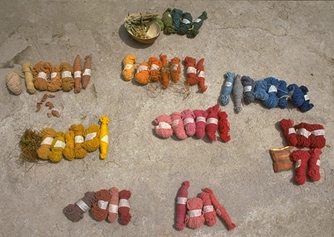| ||
|
Magdalena, who is responsible for overseeing all they family's dying, talks about where some of the natural dyes come from:
"Each pot of dye gives several different shades of a color. The color of the first yarn dyed is the strongest, and each additional use gets softer.
"This red we get from the cochineal, a little insect that lives on the nopal cactus. The color of most of the natural dyes is soft, but by adding lime juice to the cochineal, we can get a brilliant red.
"We use three different plants to get the yellows, and each one gives four different shades from successive dyes.
"Another red comes from brazil wood. To make this dye, we soak the brazil wood in water for two months.
"The brown dye that comes from pecan shells is also made this way. We use several different parts of the pecan tree to get our browns, including the roots, the leaves, and the shells. The shell gives a stronger color than the leaves.
"Some of the dyes, like the cochineal and the indigo, don't take months to prepare. We just mix them with water. The leaves and flowers of the indigo plant gives various shades of blue.
"Some of the colors come from a combination of dyes. There is an orange, for example, that comes from first dying the yarn red and then dying it orange. A green comes from that same process."
|
||
|
The Zapotecs | FAQ | Gallery | Site Map | The Store | About Artisans in Focus | E-mail
|

